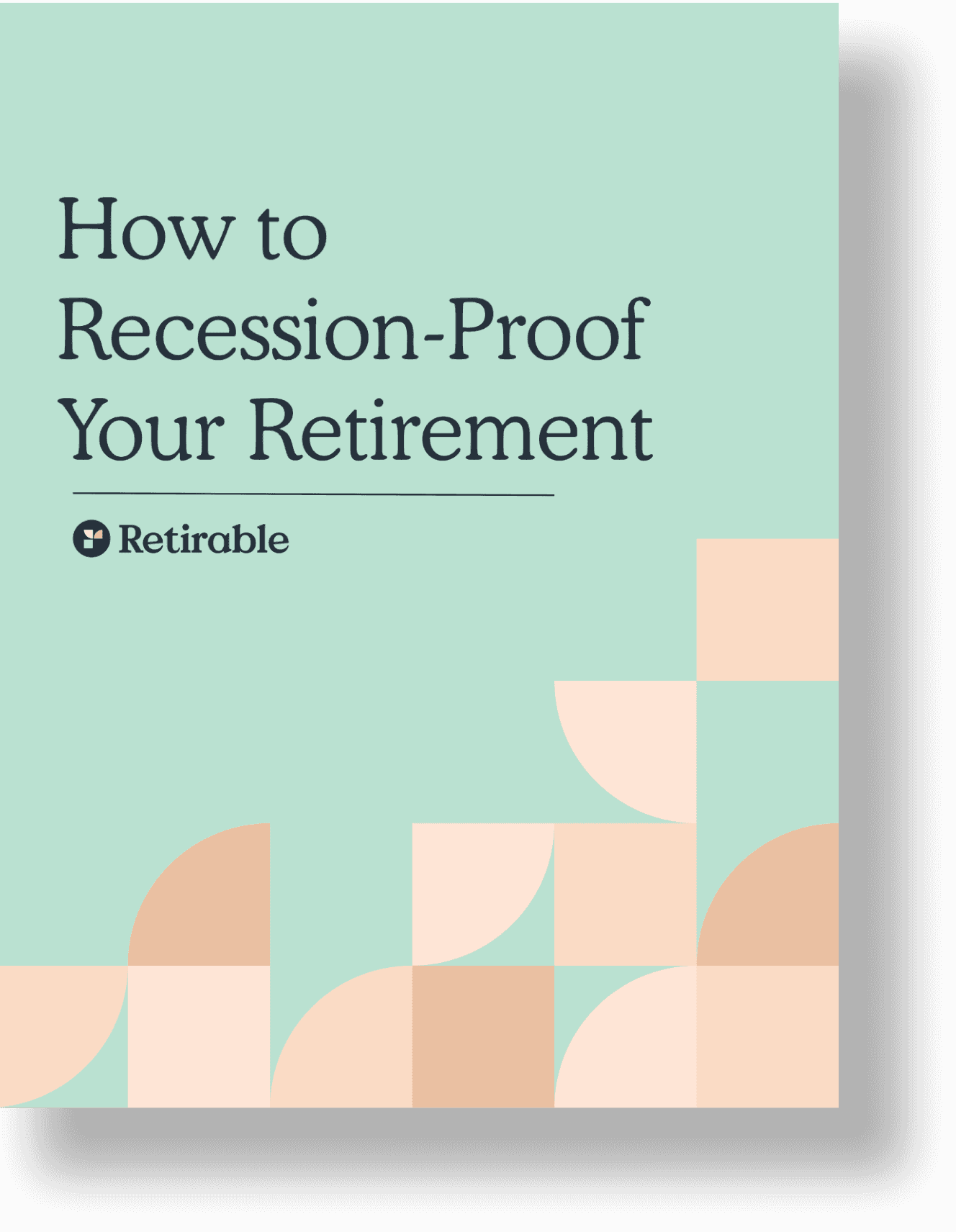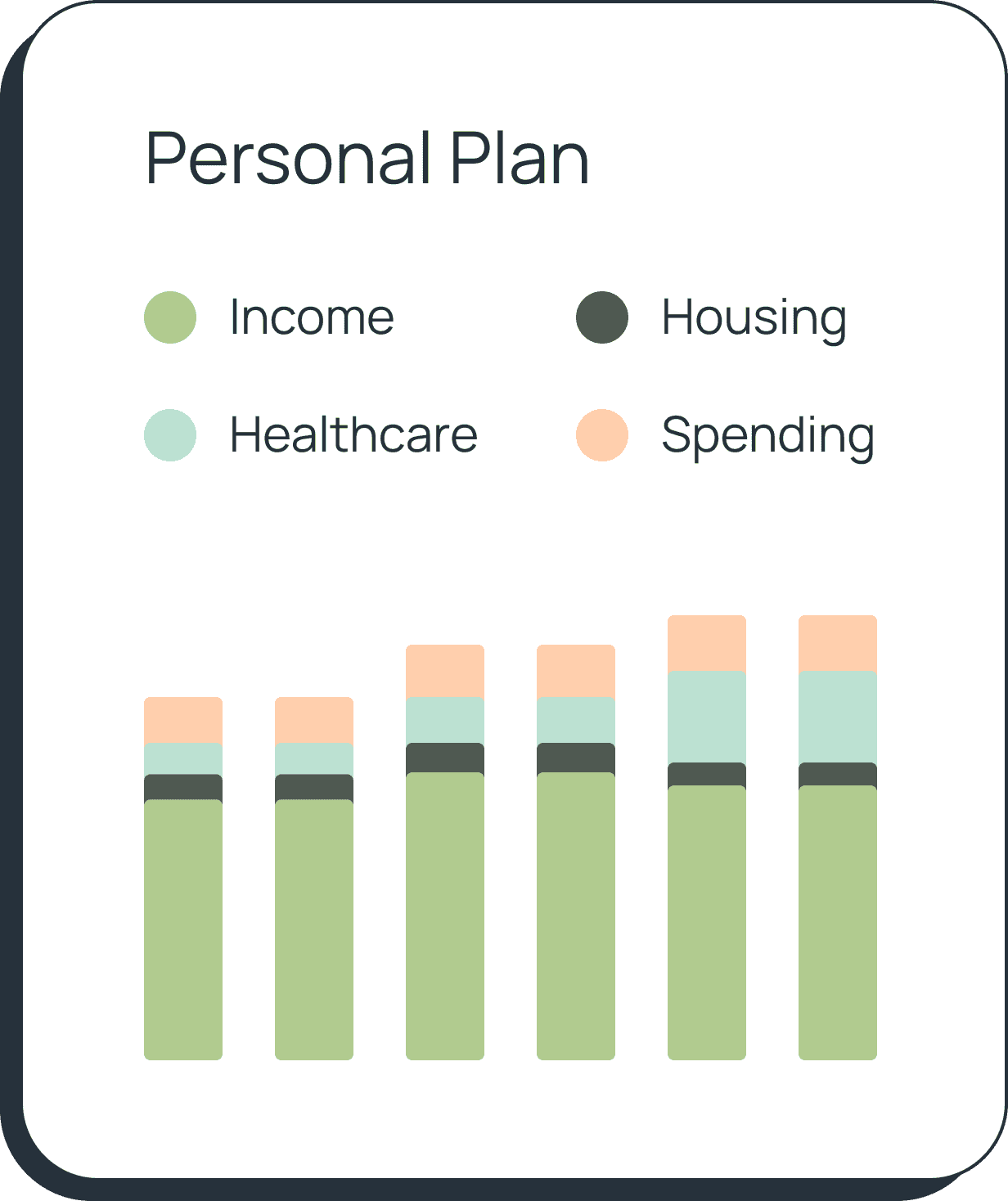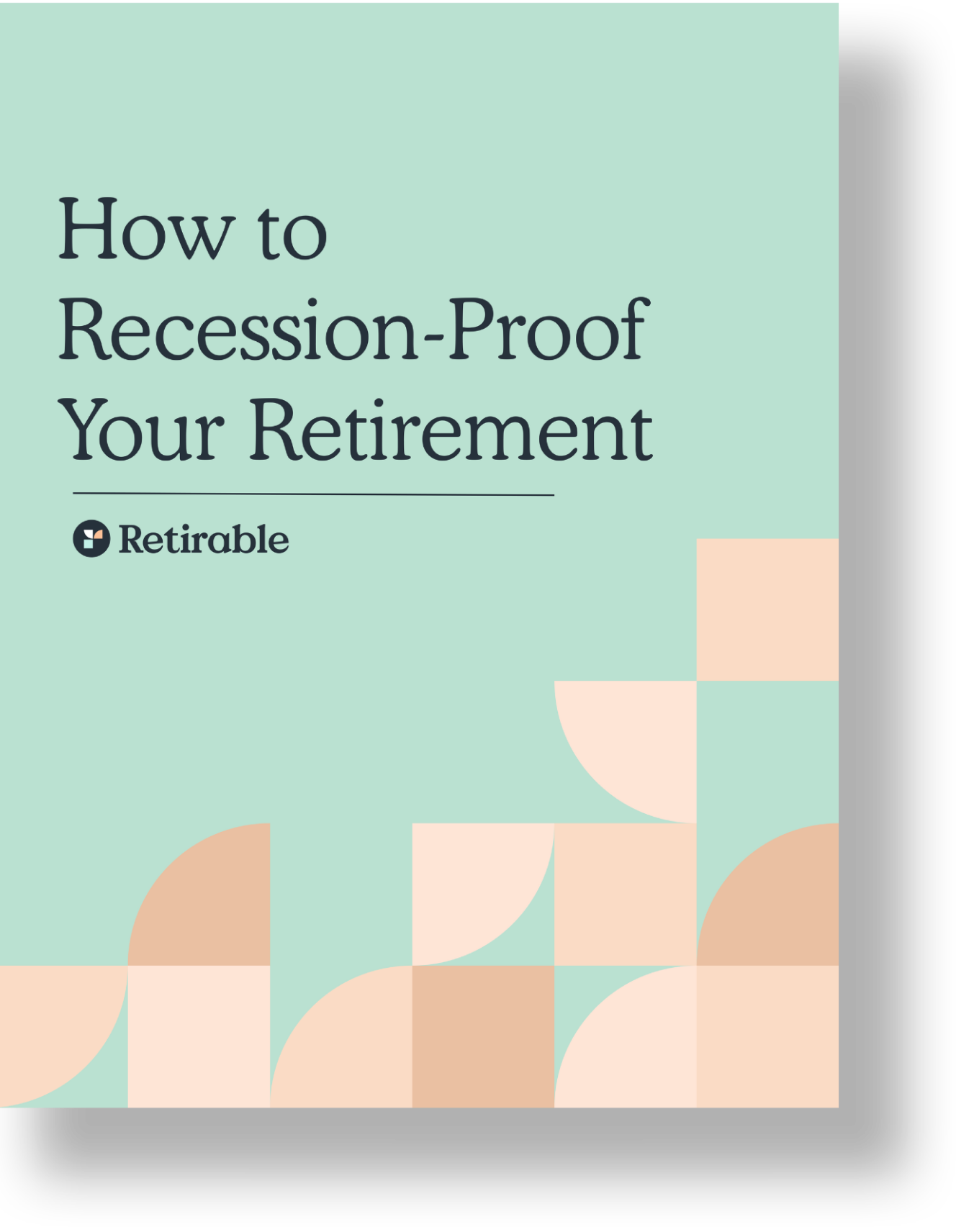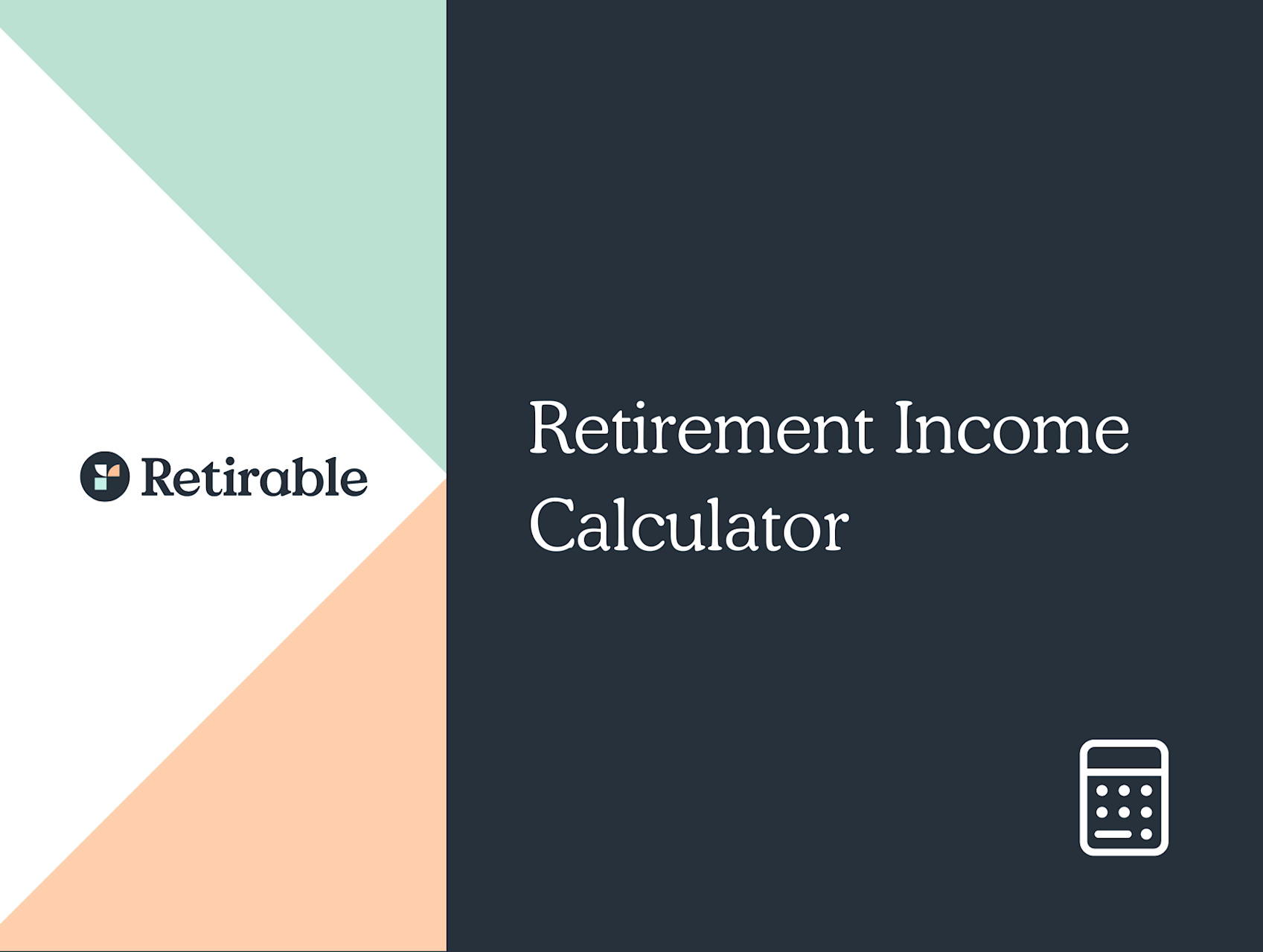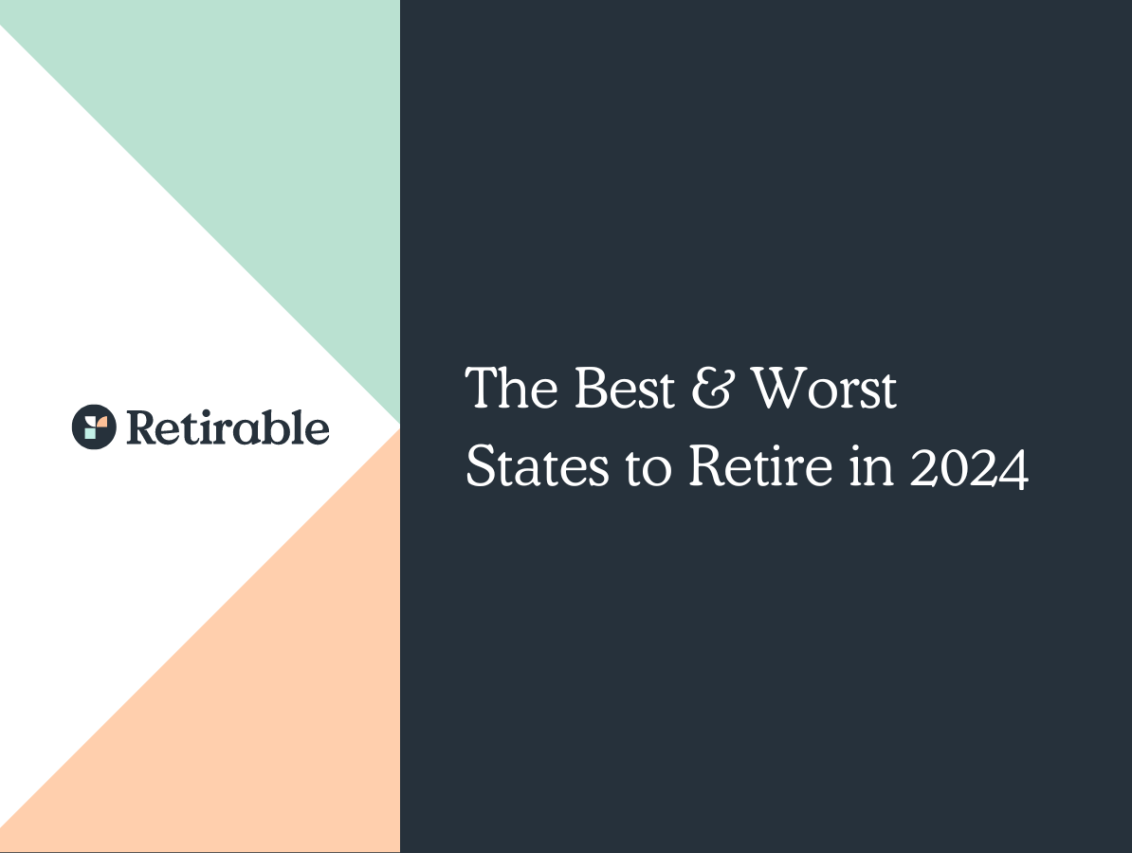Retirement
In your younger working years, retirement was just a faraway dream. But as the decades go by, you’ll start to see it looming closer, and excitement can turn to worry. Are you truly financially prepared for retirement?

C.E Larusso
•
Published February 18th, 2025
Table of Contents
Key Takeaways
Retirement planning is the process of examining your income and spending patterns to determine how much you will need to save for retirement
If you aren’t already saving through an employer-sponsored 401(k) or 403(b) with matching contributions, start as soon as you can
$1 million isn’t the same in California as it is North Dakota—knowing your specific lifestyle goals and talking to financial advisor is the best way to plan
In your younger working years, retirement was just a faraway dream. But as the decades go by, you’ll start to see it looming closer, and excitement can also turn to worry. Are you truly financially prepared for retirement?
What is Retirement Planning?
Retirement planning involves setting your retirement income goals and determining the steps necessary to achieve them. If your dream is to live out your golden years on a beach in Hawaii, you’ll need to know how much money it’ll take to get there. Retirement planning involves looking at your current income, reviewing your expenses and spending habits, knowing how much you can save each month (and then sticking to it), and managing risk with your investments. Retirement planning should be something you start as soon as you can, though you shouldn’t feel bad if you haven’t done it yet—it’s complicated and involves some math, which we know some people are averse to. Luckily, we’re here with a comprehensive guide so you can get started today.
When can you retire?
You might have your eye on the earliest retirement date available. But that’s not always the best idea. Yes, you will be eligible for Social Security but if you choose to elect at that age, you’ll reduce your monthly Social Security payment substantially. If you were born after 1959, your benefits will be reduced by 30 percent and any spouse’s benefits you receive will be reduced by 35 percent compared to electing at full retirement age (FRA).
One of the most recommended retirement strategies is to wait until age 70 to retire, when your benefits top out. You’ll get a full 132 percent of what you’d get if you retire at full retirement age, which is age 67 if you were born in 1962 or later. It’s also important to look at any pensions you receive and the minimum retirement age.
Calculating how much you need to retire
The process of calculating how much you need to retire and at what age you can retire requires taking a close look at your spending habits and planned lifestyle in retirement. Generally, though, you should assume you’ll need about 70% of your pre-retirement income each year of retirement. So a person who makes $100,000 would want $70,000 to match their pre-retirement lifestyle and spending habits.
If you have some savings already and wish to see how we think the amount current stacks up for retirement, check out our articles detailing the longevity of different pots of money:
- Can I Retire On 100k?
- Can I Retire On 200k?
- Can I Retire On 300k?
- Can I Retire On 400k?
- Can I Retire On 500k?
- Can I Retire On 1 Million Dollars?
- Can I Retire On 2 Million Dollars?
Steps to Starting Your Retirement Plan
Retirement financial advice can be all over the place, especially if you’re listening to a variety of experts. But your retirement planning is unique to your own planned retirement age and financial needs. Here are some steps to take to get started preparing for retirement.
Step 1: Calculate how much you need to retire and at what age
Rather than focusing on your income, look at your yearly spending patterns. There’s a few reasons for this: namely, your income might fluctuate over the years, especially if you go back to school or change careers at any point. Second, you could be spending more than you earn (and be in debt) or way less than you earn. Focusing on income is not a solid foundation to calculate your retirement needs.
Looking at your expenses, however, can give you a good picture of what you spend your money on and how much of it you spend. Obviously, spending changes as we get older. We might, for instance, have additional healthcare costs, and will want to make room for larger expenditures like travel. That said, you won’t have to worry about paying for your children (as they would presumably be grown and out of the house), or possibly a mortgage. Spending shifts, and it’s an imperfect way to look at the numbers, but it’s still the best metric to use.
To use your spending costs to determine how much you need to retire, multiply them by 25. That is the ballpark amount you’ll need to safely withdraw 4% every year during retirement. So, if you spend $30,000 per year now, multiply that by 25 to get $750,000, which is the amount you’ll need in your portfolio by the time you start retirement. Every situation varies, consult a financial advisor to find the right metrics for you. Of course, everyone retires at different ages, and that is sometimes dictated by how much savings you’ve accumulated.
If you want to figure out when you’ll have the magic 25x amount to kick work to the curb, you should:
- Start with that 25x amount
- Subtract the amount you have currently saved
- Try to determine what your current savings will be at age 65 by entering that number into a compound interest calculator, using an assumed growth rate, like 6% as an example.
- Subtract that amount from your 25x number
- Divide that result by the amount you think you can save each year until retirement; that number is the number of years required to reach that goal
Here’s an example of how this works:
- If your 25x number is $750,000, as we defined earlier, you’d start by subtracting the $50,000 you already have saved to get $700,000. $700,000 is now your goal savings amount.
- If you’re 30 years old, the $50,000 will be worth roughly $384,304 (6% compounded annually) by the time you turn 65.
- Subtract $384,304 from the $700,000 you need for a new total of $315,696.
- If you believe you can save $10,000 a year, you’d divide $315,696 by $10,000, which equals 31.5, but let’s round up to be safe and say 32. That means that you could retire in 32 years, or at age 62. If accounting for the same 6% compounded annual interest, you would need to save approximately $3600 a year.
This calculation, of course, is just an estimate. There are other factors at play, such as inflation. The 6% return rate is just an estimate, and will change depending on how the money you save is invested, though it’s a reasonable amount to start with and use as a guide.
Step 2: Prioritize your financial goals
As you look at your steps to retirement security, you may have other financial goals mixed in. In your 20s, you could be preparing to buy a home. In your 30s, you may finally commit to getting out of debt for good. All of these financial goals are important, too, but how do you squeeze retirement savings in at the same time?
An important part of how to start a retirement plan is prioritizing your savings goals. A typical retirement guide might not take that into account. In your younger years, building an emergency fund, saving for a downpayment on a home, and paying off debts like student loans and credit card bills will likely take top priority. To keep yourself on track, set a dollar or percentage goal and have the money automatically moved into a dedicated retirement savings account with each paycheck.
To determine how to prioritize your goals, you should ask yourself the following:
- How much do I need for this goal?
- When do I need to reach my goal?
- Where should I place my savings?
For short-term goals, you might consider CDs, high-yield savings accounts, or short-term bonds. For longer-term goals, investments with more risk, such as stocks, can be considered, alongside easy-to-implement strategies, like your employer-sponsored 401(k) plan to start saving for retirement.
Step 3: Choose a retirement account based on your long-term goals
You should pick the retirement account that is the most applicable to your life situation and goals. Obviously, if your employer offers a 401(k) or a defined benefit plan, you should enroll and start making contributions from your paycheck. In addition, opt in to any matching contributions that your employer offers.
If you’ve maxed out your 401(k), or don’t have a workplace that offers one, consider one of the IRA accounts outlined below. If you expect to have a high income later in life, you should consider a Roth IRA, as these allow for tax-free income from your distributions. Regardless of which you choose, pay close attention to the tax implications and how it might affect your situation during retirement.
For the self-employed or business owners, there are other options to consider like Simple and SEP IRAs. Some of these allow you to cover your spouse as well as yourself (if they are on payroll), but don’t cover any employees you might have.
Types of retirement accounts Take a closer look at the various kinds of retirement accounts available to help make a decision about where to put your money.
401(k): Your 401(k) is a retirement account that is typically sponsored by your workplace. Employers set up 401(k)s or 403(b)s to allow you to deduct a portion of your paycheck into retirement savings. Your company might offer matching contributions, which is basically free money—it’s money they will match based on how much you contribute, usually up to a certain percentage. So, for instance, if you contribute 4%, they might contribute the exact same, but put a cap on the percentage at 5%, even though you can exceed 5% in your personal contributions. 401(k) and 40b(b) plans are also known as defined contribution plans.
Defined-benefit plans: Sometimes called pensions, these plans are when companies guarantee their workers a set benefit during their retirement. Employers put funds into a pool, and the pension plan would then invest it. While rare now, pensions still exist for some government and union jobs. Next, we’ll define various IRA accounts. The IRA is a very common retirement plan, and can be opened at a bank or brokerage firm to earmark investments such as mutual funds, stocks, and bonds for your retirement. There are limits to how much you can contribute to an IRA each year, and they are subject to taxes based on deposits and withdrawals—these rules vary depending on the type of IRA you have.
Roth IRA: Roth IRAs can save you in taxes in the long run. Because the money contributed is taxed, the distributions during retirement are tax-free. Roth IRA retirement withdrawals can happen penalty (and tax)-free after you turn 59 ½ and you can withdraw the contributions (but not the investment earnings) at any time, because you already paid taxes on those contributions before moving them into the Roth IRA. The downside of Roth IRAs is that there are income eligibility limits. In 2025, you can only contribute a maximum of $7,000 per year if you are under 50 and $8,000 if you are over 50, assuming your (single) income is below $138,000. If your income is between $138,000 and $153,000, the contribution limits are reduced. For those who make over $153,000, contributions are phased out.
Traditional IRA: With traditional IRAs, you make pre-tax contributions to an account, and the investments grow on a tax-deferred basis. Your retirement withdrawals will be taxed. Your contributions might be tax-deductible, however, as the amount you contribute allows you to state a lower income amount—i.e. If you make $50,000 but contribute $5,000, your taxable income will decrease to $45,000. Like Roth IRAs, there are contribution limits. You can contribute up to $7,000 in 2025, even if you’re also contributing to a workplace savings plan like a 401(k). Those 50 or older can contribute an additional $1,000 per year.
Self-directed IRA: A self-directed IRA allows you to hold alternative investments, like real estate and precious metals, that aren’t allowed to be held in regular IRAs. SDIRAs are only available through specialized firms that manage these kinds of accounts. The same contribution limits as other IRAs apply; you can choose to set up your SDIRA to become a Roth IRA or traditional IRA, depending on what kind of tax structure you want on your account.
Simple IRA: SIMPLE (Savings Incentive Match Plan for Employees) IRAs are savings plans intended for small businesses with 100 or fewer employed as well as the self-employed. Employers can make a non-elective contribution of 2% an employee’s salary, or make a dollar-for-dollar matching contribution up to 3%. In 2025, the maximum annual amount an employee can contribute to their SIMPLE IRA is $16,000, with an additional $3,500 catch-up contribution allowed for those over 50. SIMPLE IRA withdrawals are taxed, similar to traditional IRAs.
SEP IRA: SEP IRAs, or Simplified Employee Pension Plans, are intended for business owners and self-employed people. SEP IRAs allow you to contribute much higher limits than traditional IRAs; the 2025 maximum is $69,000. That said, the contribution limits cannot exceed the lesser of a) 25% of your compensation, and b) $69,000, the limit for 2025. In addition, there are no catch-up contributions allowed. The taxation works like that of traditional IRAs: the distributions will be taxed as income. But your contributions are tax-deductible, and if you’re a small business owner, the contributions you make to your employees’ accounts are tax-deductible as well.
Solo 401(k): Solo 401(k)s are for self-employed people without any employees. You can use the plan to cover yourself as well as your spouse if they earn an income from your business; you just can’t have anyone else on payroll. You can choose to enroll with a traditional 401(k), where distributions will be taxed as income, or as a Roth solo 401(k), which allows you to take your distributions tax-free, as contributions are taxed. The maximum contribution in 2025 is $69,000, with an additional $7,500 catch-up contribution allowed for those 50 and older.
Step 4: Diversify your retirement investments
Diversification is key to having a healthy investment portfolio. It doesn’t mean that your portfolio will overperform, but it does help to improve returns for your level of risk. Look for investments (stocks, bonds, cash savings) that have moved in different directions, so if one investment is on the downturn, the others are likely to be growing. You should look for diversification within each investment as well. For instance, don’t over concentrate within your stock holdings—make sure you have a mix of different stocks in your portfolio. Opt for various kinds of bonds instead of just one, and look at the alternative sources of savings and income we list below.
Types of retirement investments
In the interest of diversifying your portfolio, consider all types of retirement investments to round out your portfolio. If you’re having trouble deciding which is best for your retirement goals, speak to a dedicated financial advisor.
Real estate: If you already own your home, it could be a part of your retirement plan down the line, assuming it is worth more than your mortgage when you wish to retire or you have paid off your mortgage in full and wish to sell and downsize. In addition, you might own or want to consider investing in rental properties; obviously, these investments require significant upfront cash to cover the down payment and come with specific tax liabilities.
Retirement accounts: As we described above, your workplace may offer a 401(k) or 403(b) with matching, which is a great way to start your retirement planning. Once you have maxed those out, look into an IRA—Roth or traditional—and then some of the other retirement options mentioned here.
REITs: REIT stands for “real estate investment trust.” These companies own and operate real estate such as apartment buildings, storage facilities, hotels, and other commercial sites. As an individual investor, you can purchase an equity stake in a REIT holding. REITs are required to pay 90% of their annual income as shareholder dividends, so they can offer the highest dividend yields in the market. That said, non-traded and private REITs can take a long time for any potential gains to be realized. You can buy REITs through any brokerage account, just as you would a stock.
High-yield savings accounts: High-yield savings accounts are usually opened through online banks and credit unions and offer much higher interest rates than traditional banks. They work exactly the same as other savings accounts—you simply deposit money when you want, and withdraw when you want (though note there might be a penalty for withdrawing too often in a certain timeframe, like 30 days). People sometimes use high-yield savings accounts to sock money away for a very specific goal, such as a mortgage or new car, but they can also be a part of your comprehensive retirement planning.
Our high-yield savings account helps you spend retirement with more.
Earn more on your cash savings with Retirable.Short-term CD: A CD, or certificate of deposit, is a savings tool offered by banks, credit unions, and brokers. CDs have high interest rates, with the caveat that you must keep the money in the bank for the predetermined amount of time, versus a traditional savings account where you can withdraw whenever. CDs are very safe investments, and the maturities range from one month to five years or more.
Step 5: Prepare for the impact of inflation and new regulations
Over the past year or so, the cost-of-living has been going up (and up…and up…), thanks to inflation driven by a series of supply chain issues, the global COVID-19 pandemic, and the war in Ukraine. People are feeling the pricing pressure at the supermarket, the gas station, and at restaurants. Here are a few quick tools for re-strategizing with inflation on the rise:
- Review your spending and see if there are places you can cut back and save more—even if it’s cooking in and staying home one extra evening a month instead of going out, it counts.
- Consider purchasing I Bonds as a new retirement investment, as these bonds have interest rates adjusted for inflation.
- Short-term certificates of deposits could be one tool to get a high return on your funds quickly, and then re-allocate the money to a different savings account once inflation has leveled off.
And now for some good news: the Social Security Administration raised benefits to meet the COLA (cost-of-living adjustment), so those who are collecting their checks will see those changes.
In addition, if you are already taking your benefits, have not reached your full retirement age (FRA) and are still working, you will have $1 withheld for every $2 you earn above the earnings limit—that limit, though, has jumped from $19,560 in 2022 to $21,240 in 2023. If you’re able, consider waiting to collect your Social Security benefits until you’ve at least reached your FRA or hit the maximum age of 70, as your benefits will be worth much more the longer you hold out.
Step 6: Prepare for decumulation and adopting a “spend” mentality in retirement
The Center for Retirement Research at Boston College reported that half of retirees are nervous about spending from their hard-earned savings on leisure activities. It makes sense, of course, that if you’ve spent so many years saving money and preparing for the worst, that it would take some adjustment to feel comfortable with spending your money more liberally on pleasurable activities like travel and hobbies.
But it’s important to remember that retirement is a time to focus on your remaining years and spend them as enjoyable as possible, while staying within your budget; it’s what you’ve spent your entire working life getting ready for. Instead of buying inexpensive packaged food to save money, cook at home with fresh fruits and vegetables, which are better for your health. Travel to places you have always longed to travel to, or pick up a new hobby with a good friend. These activities and choices make a will difference on your overall well-being, both mental and physical.
If you are years away from retiring, try to imagine the kinds of things you’d like to do when you no longer have to show up for work every day. It could be as simple as gardening every day, or involve more complicated goals, like traveling to every national park. Thinking of your future without work and what you’d like to do will also help you financially save for that time, so you can do it all without worry.
Step 7: Consider reviewing your retirement plan with an advisor on an ongoing basis
It’s never too early or too late to schedule regular reviews of your investments and make sure you’re on track. This work, of course, is best done with the help of a dedicated financial advisor, who can help make sure you’re allocating your savings in the best way possible, developing a strong budget, and making sound financial decisions.
Frequently Asked Questions
What are the three biggest pitfalls to retirement planning?
Planning is difficult amid market shifts, and we see people sell assets during the first downturn, which can make it difficult to recoup losses if the market rallies again. Given this, you might consider, instead, adjusting your allocations to holdings that are better prepared to handle any market ups and downs.
Second, we suggest waiting as long as possible to collect your Social Security benefits. The longer you wait, the higher the benefits will be, and collecting too early, especially if you continue to work, could have a serious impact on the amount offered to you.
Finally, you will need to consider when you need to take some withdrawals from your savings versus when you must take withdrawals (based on RMDs), and the tax implications of each.
How long will a million-dollar 401k last?
There’s not a single answer to this, as your retirement goal is dependent on many factors, including: where you want to live, your health, preferred lifestyle, other retirement income sources, and inflation. For instance, $1 million in Hawaii is projected to last just 11 years, while the same amount can last over 25 in Mississippi; the difference is that goods and services are much more expensive in Hawaii. In addition, one person may wish to spend their retirement years traveling the world, while another may be comfortable staying at home and gardening—these lifestyle choices will greatly change how much you need to save, and how far your current savings will get you.
What is a good monthly retirement income?
When comparing the 2020 U.S. Census and the latest 2023 U.S. Census, the median retirement income for those 65 and older increased from $48,866 to $54,710. That said, the amount you will need will depend on your lifestyle, health, and other factors. Generally speaking, most experts state that you will need 70-80% of your pre-retirement income to maintain the same standard of living in retirement.
Share this advice

A professional content writer, C.E. Larusso has written about all things home, finance, family, and wellness for a variety of publications, including Angi, HomeLight, Noodle, and Mimi. She is based in Los Angeles.
Share this advice

A professional content writer, C.E. Larusso has written about all things home, finance, family, and wellness for a variety of publications, including Angi, HomeLight, Noodle, and Mimi. She is based in Los Angeles.
Free Retirement Consultation
Still have questions about how to properly plan for retirement? Speak with a licensed fiduciary for free.

